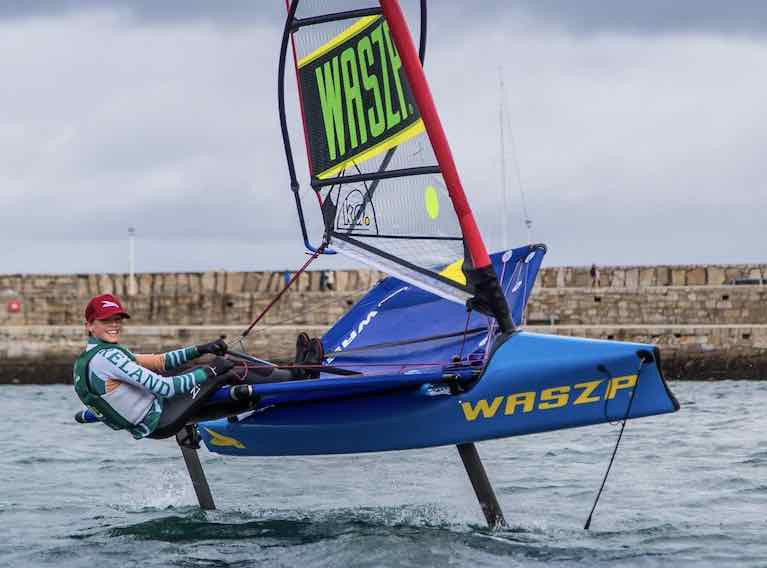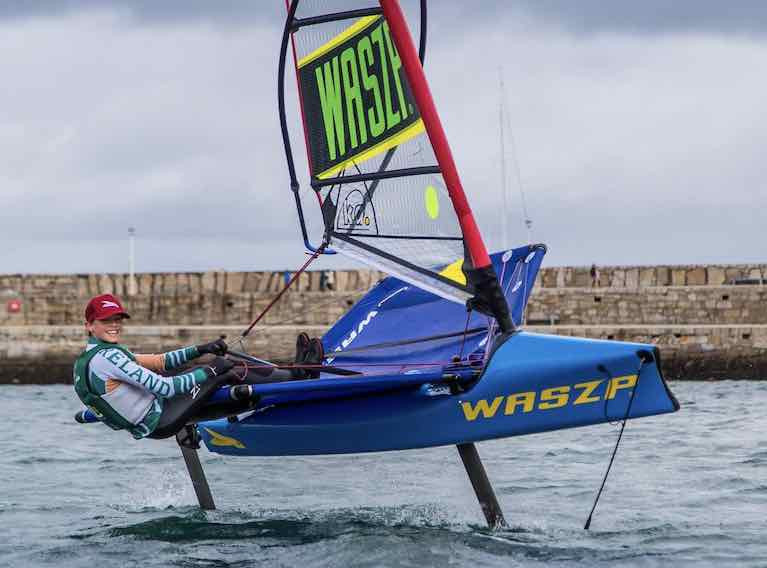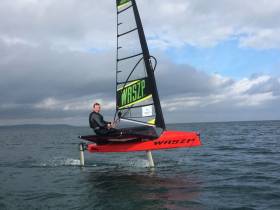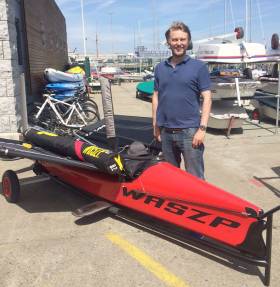Displaying items by tag: Waszp
Waszp Video Captures the Foiling Thrills of Irish National Championships at Royal St George Yacht Club
15 Waszp foiling dinghies, including with three from the UK, contested last weekend's National Championships on Dublin Bay.
As Afloat reported earlier here, it was hard, fast sailing in heavy winds and choppy conditions at the Royal St George Yacht Club event.
Now a class video (below) shows off more of the high speed foiling action from the Bay.
UK sailor Ross Banham as overall winner in 8.2 m fleet, followed by Arthur Fry, both from Hayling Island sailing club, UK. Henry Start of the RSGYC came a close third overall and was National Waszp champion in this fleet.
In the 6.9m fleet overall winner and national winner was Emily Conan RSGYC, followed closely by Kate Tingle RSGYC /RCYC in second and Tom Hogan RSGYC in third place.
Tom was also first master. Elysia O’Leary RSGYC was first Irish female in 8.2 fleet and Max Goodbody RSGYC/RIYC was first under 19 years in the 8.2m fleet.
Prizewinners are photographed below by Simon McIlwaine
 Waszp 2021 National Championship Prizewinners at the Royal St. George Yacht Club Photo: Simon McIlwaine
Waszp 2021 National Championship Prizewinners at the Royal St. George Yacht Club Photo: Simon McIlwaine
Start is WASZP Irish National Champion After Royal St. George Contest at Dun Laoghaire
The Waszp National Championships were held at the Royal St George Yacht Club at the weekend and 15 sailors participated, with three from the UK travelling over to race at the Dun Laoghaire Harbour venue.
It was hard fast sailing in heavy winds and choppy conditions where it was all to play for with many capsizes. The top six boats were very close and the final outcome often being decided in the last lap.
Four long races were held on the first day, and unfortunately, racing was blown out by 30+ knot gusts and 1.5m waves on Sunday.
Race Officer Barry O’Neill and his team set some good race courses in challenging conditions.
 Hattie Rogers, one of three UK visitors for the Irish Waszp Nationals at Dun Laoghaire Harbour
Hattie Rogers, one of three UK visitors for the Irish Waszp Nationals at Dun Laoghaire Harbour
The overall winner in 8.2m fleets was UK sailor Ross Banham followed by Arthur Fry, both from Hayling Island Sailing Club, UK.
Henry Start RSGYC came a close third overall and was National Waszp champion in this fleet.
Max Goodbody RStGYC/RIYC and Marcus O’Leary RSGYC came second and third in the national 8.2 fleet.
In the 6.9m fleet, the overall winner and national winner was Emily Conan RSGYC, followed closely by Kate Tingle RStGYC /RCYC in second and Tom Hogan RStGYC in third place. Tom was also the first master.
Elysia O’Leary RStGYC was the first Irish female in 8.2 fleet and Max Goodbody RSGYC/RIYC was the first under 19 years in the 8.2m fleet.
The nations trophy went to the UK team and the First Traveller trophy to Hattie Rogers Royal Lymington YC.
Duncan Hepplewhite from Sailing Fast UK came over to support and sponsor the event.
Henry Start, Event Chair told Afloat "We were delighted with such good numbers for this event and the standard was excellent".
Results here
Foiling Waszps Are Swarming for Irish Championships at Royal St. George Yacht Club This Weekend
In a big year for the Irish Waszp class in which Royal St. George sailor Charlie Cullen (19) became European Slalom Champion and Junior (U20) European Champion, the class will host its Irish National Championships at the Cullen's home club in Dun Laoghaire Harbour this weekend.
The Waszp is singlehanded, one design foiling boat that's meant to be affordable, durable, easy to learn and excellent to race.
Organisers say the event will see 15-20 Irish boats on the start line and that "a number of sailors from the UK and perhaps even Norway and Switzerland will come to race in the event".
The Race Officer for the event is DBSC one-design race officer Barry O'Neill.
The event will consist of three fleets. There will be fleet racing for the 8.2m and 6.9m on the same start and course.
There will be separate racing at the same time for the beginner Waszp sailors. Sailingfast, the UK supplier of Waszps, will be the sponsor of the event.
Cullen, however, cannot participate due to a clash with the All Ireland sailing championships in Cork, to which he is an invitee.
The Waszp is a foiler designed for children aged 11-14 years old and between 30-45kg. This allows one boat to take a sailor through from 30kg to 90kg with some minor and relatively inexpensive adaptations as they progress through each rig. Across the world, there are over 1200 waszps and nearly 20 waszps in Ireland. The Waszp class has an excellent gender balance, with almost half of all Irish Waszp sailors being female.
Royal St. George Waszp Sailor Charlie Cullen Wins Ireland's First Ever European Waszp Title
Royal St George sailor, Charlie Cullen, 19, is Waszp European Slalom Champion and Junior (U20) European Champion following this year's Waszp European Games in Lake Garda Italy.
Held in beautiful Circolo vela Arco, a competitive and experienced 87 boat fleet emerged representing 18 countries from around the world to fight for the 2021 European championship titles.
A month earlier Cullen, from Dalkey in Dublin, secured a Silver medal at foiling week in Malcesine with a thirty boat International fleet.
Day 1 and 2 of the European Games event saw the slalom competition in full force. The slalom event is a quick and fast downwind circuit, with races only lasting a few minutes. Before the finals, there were several heat events with each race being a knockout for those that finish outside the top five places.
In the very first race of the day, Charlie IRL 2987 almost found himself out, after capsizing in his first gybe. However, after a quick recovery, Charlie scrapped his way into the next round finishing 4th in a 3-way photo-finish with 4th, 5th and 6th.
 Charlie Cullen on the podium in Italy
Charlie Cullen on the podium in Italy
He managed to cruise his way through to the finals scoring 1st in both the quarter-final and Semi-final heats respectively. With a dying breeze, the finals were postponed to the following day.
After a 5 am wake up the Championship Fleet began racing for 5 hours in a 20 + knot north Peler wind that morning. Then after the fleet races, the top 10 slalom finalists gathered to race that afternoon in the famous Ora wind of Lake Garda.
Charlie, the only Irish to qualify for the finals - was on form winning the first race, with previous European slalom champion Elliot Savelon from the Netherlands hot on his tail.
However, Cullen, keeping his composure, finished 2nd and 3rd in the last two races of the final, thus scoring a 1,2,3 in the finals to become The 2021 Waszp European Slalom Champion.
The following days saw Championship Fleet racing unfold. With blistering temperatures, the famous afternoon Ora breeze of Lake Garda failed to fill in long enough for racing. This called the fleet again to an early 8 am first gun start for the 4 days of racing.
In the 20 knots of the morning Peler, and closing speeds of 30 – 40 knots the racing was quite a spectacle. The Waszp class standard has become higher and higher over the years resulting in extremely tight and exhilarating racing.
After winning the Slalom, he was one to watch in the battle for the overall title. Charlie port tacked the entire 87 boat foiling fleet resulting in a bullet becoming one of the many race winners. But with the tough conditions and tight crosses, he was struck with bad luck with a major collision with the helm of the other Waszp physically being flung through Charlie’s mainsail causing his sail to be written off and forcing him to miss two races of the day.
After getting redress, he was still in the fight for a top 10 overall and the Under 20 title. On the final day, he found his form getting a top 10 and a top 5 in the last races. This was enough for him to finish 10th overall and for him to be crowned the Waszp 2021 Under 20 Junior European Champion.
Matt Beck of GBR took the overall, with Germany’s Paul Farien and Italy’s Francesco Bertoni finishing the podium.
There was a strong Irish contingent, with six boats flying the flag. The young Irish fleet was represented by Royal St. George Sailors, Georgia Goodbody, Elysia O’Leary, Marcus O’Leary, Max Goodbody and Henry Start.
Three of the six boats received some top 10 results. With some incredible starting masterclasses from Marcus O’Leary and Max Goodbody who ported tacked the 87 boat fleet on multiple occasions. Max finished 30th, Marcus finished 39th overall and Henry Start finished 51st overall.
Georgia Goodbody and Elysia O’Leary both had a great event completing all the races in the tricky conditions. With Elysia finishing 64th and Georgia finishing second in the 6.9 category, 75th overall.
Full results are here
Dun Laoghaire Harbour's Charlie Cullen of RStGYC came second at this year’s foiling week in the Waszp class held in Fraglia VelaMalcesine, on Lake Garda which finished yesterday, with Netherlands Paul Hameeteman taking first place and Denmarks Jeppe Borch finishing third.
Charlie, 19, was the only Irish representative at the event which attracted over 100 boats in various classes with world-class sailors from almost twenty countries.
Foiling Week is an event dedicated to foiling which involved clinics with International champions including Olympic gold medallists Tom Slingsby and Paul Goodison. Other competing champions were Francesco Bruni, Ian Jensen and Billy Besson.
It was quite a spectacle with over 60 Moths, 30 Waszp and other foiling boats on the lake, The racing was very tight and super exciting.
 Charlie Cullen of the RstGYC IRL 2987 (Purple Mast) Charlie Cullen of the RstGYC IRL 2987 (Purple Mast) at Fraglia VelaMalcesine on Lake Garda Photo: Martina Orsini
Charlie Cullen of the RstGYC IRL 2987 (Purple Mast) Charlie Cullen of the RstGYC IRL 2987 (Purple Mast) at Fraglia VelaMalcesine on Lake Garda Photo: Martina Orsini
There were demos to try out foiling bikes, boats and foilboards. Also, ideas of developing new foiling technologies with sustainability in mind were shared.
There were 4 days of racing. Day 1 was cancelled due to no wind, but they got 10 very competitive races over the 3 days.
It was exhilarating sailing with great racing and a great group of people and no doubt foiling is the future.
The next big event on the Waszp foiling calendar are the waszp Europeans in August that will be hosted in Circolo Vela Arco in Lake Garda and there is expected to be a good Irish contingent.
Charlie Cullen Just Pipped for WASZP Big Prize
Irish WASZP youth sailor Charlie Cullen was pipped by an Australian Olympic sailor for first prize in last weekend's climax of the Global GPS Racing Dinghy Series.
The Dun Laoghaire Harbour skiff sailor was in pole position to win the first prize of two spectator tickets to a Sail GP event and a ride on an F50 catamaran but canny Australian Brad Devine pipped him to the post right on the event deadline.
The first-year Trinity College Dublin Engineering student made a real stab of juggling his studies and the big waves on Dublin Bay to try and win the world challenge and very nearly did.
More here
Dublin Bay WASZP Sailor Charlie Cullen Tops Global GPS Racing Series
Dun Laoghaire Harbour WASZP sailor Charlie Cullen is in pole position to win the first prize of two spectator tickets to a Sail GP event and a ride on an F50 catamaran following his own foiling exploits in the class’s global GPS racing series.
WASZP sailors, including Cullen, have been competing over an event window from September 14th – October 12th and the Dublin Bay teenager is currently top of the rankings with just three days left to sail.
The beauty of this initiative by WASZP is that sailors from every corner of the globe can race against each other and continue to compare themselves against the best. This, say the promoters, is using the best aspects from windsurfing and kitesurfing and integrating it into the more traditional racing/event formats.
 Waszp Sailor Charlie Cullen with his top speeds recorded by GPS
Waszp Sailor Charlie Cullen with his top speeds recorded by GPS
Because of the nature of the event, sailors are not scored just on the fastest speed. The sailors are scored on three categories:
- Average top speed
- Best 250m run
- Total distance sailed in 1/2 an hour (calculated off your average 1/2 hour speed.)
Charlie's winning runs clocked the following:
- Sailed a total distance of 52km
- Max 2sec at 24.53 knots.
- Half hour average speed of 16.01 knots
Will this be the winning time by the deadline?
More details on his rise to the top here
Want To Learn To Foil? Check Out This New Survey
#HowToFoil - Waszp agent John Chambers has launched a survey to gauge public interest in learning to sail foiling dinghies this year.
As previously reported on Afloat.ie, National Yacht Club member Chambers brought the Waszp to Ireland last year after pioneering Moth sailing at Dun Laoghaire’s waterfront.
The Waszp was devised as an answer for dinghy sailors who didn’t quite feel comfortable with the standard International Moth.
Now Chambers is attempting to determine how many people are actually interested getting to grips with a Waszp on the water via a short online survey available HERE.
National Yacht Club Member John Chambers is the Waszp foiling boat agent for Ireland. Chambers, a pioneering Irish Moth sailor at the Dun Laoghaire club is to organise demo and clinic days for NYC members.
The Waszp project was conceived in 2010 by Andrew McDougall, designer of the world beating Mach 2 foiling Moth.
The Moth is a racing boat with very few rules and therefore has developed into a boat that is beautiful to sail on the water, but not the answer to everyone’s requirements for a sailing dinghy.
The concept was for a foiler similar to a Moth, but answered all the sticking points that stop people buying a Moth.


































































